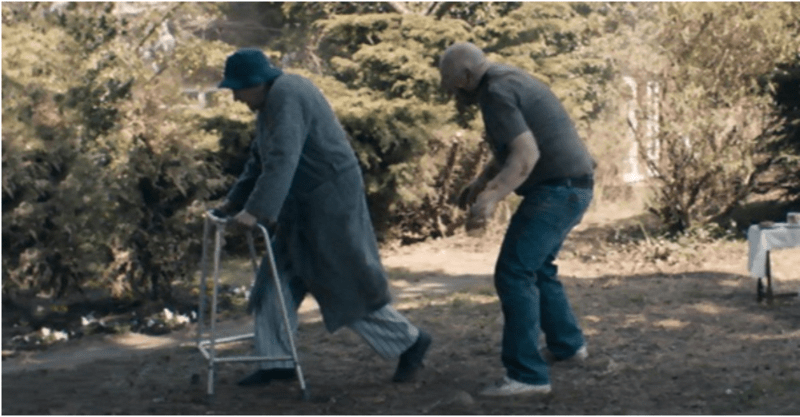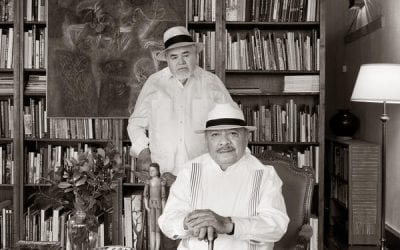The Living Dead vs. The Dying Living
Zombies and the Elderly
One of the most quoted scenes from the movie Cockneys vs. Zombies (2012) by Matthias Hoene takes place in a London nursing home, where the survivors are a group of old men and women enduring constant zombie attacks. Amid an attack, residents who have taken refuge in the kitchen try to wake up old Hamish, who is napping in the patio while the zombie apocalypse develops around him. Upon awakening and noticing those who stalk him, Hamish embarks on an improbable escape, armed with his walker and pursued closely by one of the slowest zombies the subgenre has created.
Hamish manages to escape with the help of his friends who rescue him in a wheelchair, and he later becomes an active part of survivor group. This group includes young men and women—fairly athletic adults who can handle a weapon. In an innovative spin for zombie cinema, the group also includes older adults for whom running is not an option. Featured as feisty survivors, older adults become protagonists, breaking their status as secondary characters that serve only as bait for zombies. Ray, grandfather of the main characters and temperamental war veteran, reaffirms his place as protagonist after being rescued from the nursing home, becoming the focus of the narrative’s self-restructuring.
A horror comedy, Hoene’s film creates a visual connection between the undead and those who have lived long enough for age to leave its mark. Both move extremely slowly, are unable to run, and struggle with memory, orientation or understanding, either because of age or because of the zombie virus (or toxin). Cockneys vs Zombies is one of the few films where a clear link between old age and “zombiism” is drawn while giving the elderly a central role. This shift removes the elderly from representations that perpetuate them as artifacts of consumption, gory channels (when they are devoured by zombies) or comic gadgets.
Important films for Hispanic zombie cinematography have used the elderly as ways to introduce doses of black humor and political commentary into apocalyptic narratives. In the Cuban film Juan de los Muertos (2012) directed by Alejandro Brugués, one of the first on-camera zombies is Rogelio, the old neighbor of the eponymous Juan, who seems to have died of natural causes but nevertheless comes back to life. In a series of humorous attempts, Juan and his friends try to kill the zombified old man without having the slightest idea how to do it or of the nature of the mutation.
The scene uses the same playful, transgressive tone of the rest of the Cuban film and takes to the extreme the transformation of the zombie subgenre developed in the Caribbean. Juan de los Muertos alludes to the disinformation to which the Cuban people have been subjected as a result of national media control. Because of this disinformation within the film, the protagonists never know that they are facing zombies or how to control them. Before killing Rogelio with a blow to the head, Juan and company try to impale him (like a vampire) and to control him through divine power (like a possessed person). What U.S. films is ignorance about the origin of the virus, in Brugués’s is ignorance of zombies’ nature.
Similarly, in the Spanish film [•REC]³: Genesis (2012) directed by Paco Plaza, the grandfather of the protagonist Koldo serves partly as a comic artifact that breaks up the bloody and frantic rhythm of the narrative. When the protagonist exclaims, while murdering his zombified grandfather, “me cago en mi abuelo sordo y en su puto Sonotone!” (I shit on my deaf grandfather and his fucking Sonotone!) the line is clearly meant for laughs, with Sonotone referring to a hearing aid. Precisely because of not hearing the prayers that petrify other zombies, the grandfather is able to bite one of the last survivors. This bite destroys any possibility of escape or happy ending for Koldo and his wife.
Koldo’s grandfather, who earlier in the film appeared as a venerable old man appreciated by the whole family, becomes the one who destabilizes the precarious balance established by the couple of survivors in a rapidly unravelling world. The Spanish curse expression “me cago en” marks the transgression of the venerable elder, and in some way the authority of the elderly as stewards of the future. The phrase also is transgressive against the zombie subgenre, contaminating the horror film with black humor. This humor also marks the protagonist’s surprise at the endurance of his grandfather, suggesting to the audience an occasion to similarly feel surprise: the old man who was a secondary character in the narrative is in fact able to transform it completely.
These examples are atypical: the elderly are not often explicitly represented in zombie movies, a subgenre recognized for its adultism. The protagonists of zombie films are usually adults stereotypically presumed to be able to defend themselves and survive in an apocalyptic environment. They can survive either because they acquired survival skills prior to the catastrophe or because they develop them throughout the films. These groups are rarely composed of children or older adults, who perish quickly due to the harsh conditions of the post-apocalyptic world. If they last long enough to become protagonists, they are sacrificed to create dramatic turns. This is the case of Carl Grimes, who commits suicide after being bitten by a zombie in The Walking Dead, after being, for eight seasons, the only child and teenager protagonist with centrality.
This situation differs from the role that the elderly have in other subgenres of horror. In films with satanic themes, such as Rosemary’s Baby (1968), the House of the Devil (2009), and Verónica (2017), the elderly are direct causes of horror and are in cahoots with satanic forces. In supernatural films, the elderly control and/or are controlled by paranormal entities, as illustrated by Jesús Gris in Cronos (1993), Mary Shaw in Dead Silence (2007) or the Tall Man in Phantasm (1979). In these films, seniors are fundamental for narrative development, serving as antagonists that mobilize the action and require the protagonist’s intervention. The elderly are often presented as guarantors and protectors of outdated social or religious structures, including Satanism, witchcraft and other premodern practices. Either because they see those structures threatened or because they abhor changes brought by new generations, they react with violence and try to destroy whoever gets in their way.
Despite the lack of centrality of older characters in zombie films, the iconography of the living dead contains elements that reference those who, for biological reasons, have lost cognitive or motor faculties. As asserted by Kevin Boon in his article “And the Dead Shall Rise,” zombies “do all share a common characteristic: the absence of some metaphysical quality of their essential selves. This may be the soul, the mind, the will, or, in some cases, the personality. But every zombie experiences a loss of something essential that previous to zombification defined it as human” (7). Although this definition focuses more on the loss of the “metaphysical qualities” that particularized the now-zombified humans, in the cinematographic representation of zombies this loss is accompanied by a physically visible deterioration. In most cases, the brain as an organ is clearly affected and there are marks on the bodies that account for the violence of the zombie etiology.
Different theoretical approaches to aging emphasize the loss of physical and psychical faculties due to biological, genetic, metabolic, neuroendocrine or social changes. These approaches place aging people in a space of differentiation (and in many cases of exclusion) with respect to those who can make “full” use of their faculties. Both zombies and the elderly are then delineated as beings who have lost skills and abilities that characterize them as “wholesome human beings,” and in that way they have lost part of their humanity—or in some cases, the totality. The loss can be the product of various situations, natural in the case of aging—disease or debilitation—and artificial in the case of zombiism. In these cases, the culprit is a virus, a parasite or a genetic mutation, and can be contracted by contact, ingestion or, generally, can be transmitted by a bite (given the cannibalistic nature of contemporary zombies).
The connection between aging and zombiism (in its different forms and levels) is not unique to horror movies and the zombie subgenre. It expands to other disciplines and theoretical fields. In genetics and geriatric medicine, the connection has been used to talk about so-called “zombie cells,” that is, cells that do not divide, but that do not die either. These cells are enunciated as defective or diseased since the behavior considered “normal” in a cell is division and multiplication, and if not, cell death. Also called senescent cells, these cellular bodies stagnate into a “zombie” state due to damage or disease and tend to have a greater resistance to the antibodies of the immune system. The possibility of destroying them becomes a scientific bet in the fight against aging and diseases related to this life stage. According to Megan Scudellari, in her article “To stay young, kill zombie cells” (Nature. October 24 2017), studies developed by Darren Baker et al. at the Mayo Clinic, demonstrate that “senescent cells accumulate in ageing organs, and […] eliminating them can alleviate, or even prevent, certain illnesses.”
The choice of the word zombie to refer to cells that seem dead without being dead demonstrates the reach of the figure of the zombie in areas and disciplines different from religion, literature or cinema. It also parallels the viral expansion of a figure that has moved to multiple cinematographies, including Latin American cinematography. Brugués and Plaza insert their films within the zombie geography while transgressing tropes created by the subgenre in the seventies. Juan de los muertos replaces the zombie film’s trope of physical survival with a comedic twist: the Cuban survivors prioritize profiting off the apocalypse, killing zombified family members for a fee. These survivors make the best out of a historical inheritance marked by misinformation and authoritarianism, as Rogelio’s body reminds the audience. In [• REC] ³ the irreverence directed toward the grandfather zombie permeates the film’s broader attitude toward the zombie subgenre. In Plaza’s hands, the zombie film becomes literally more irreverent: the zombies are a hybrid between the living dead and the possessed, such that [• REC]³ becomes a mixture of the zombie and satanic film.
As if it were a zombie plague, the image of the living dead popularized by George Romero has expanded throughout the globe, adapting to multiple spaces and disciplines and becoming popular as a metaphor for multiple social and geopolitical phenomena. In the case of its adaptation in medicine, the connection is traced with aging processes that, although normal, can become terrifying through an unusual relationship to the life/death binary. Either as a cinematic character or as a variation in the cellular process, the monsters that return from the grave become a vehicle to channel fears related not just to mortality, but also to aging and even the burden placed on the elderly through both cinematic symbolism and cultural stereotype.
Winter 2019, Volume XVIII, Number 2
Gabriel Eljaiek-Rodríguez is Head of Spanish Instruction and Latin American Studies at the New School of Atlanta, and Professor of Liberal Arts at the Savannah College of Art and Design. He is the author of The Migration and Politics of Monsters in Latin American Cinema (2018) and Selva de fantasmas. El gótico en la literatura y el cine latinoamericanos (2017).
Related Articles
Video Interview with Flavia Piovesan
Flavia Piovesan is a member of the Inter-American Commission on Human Rights, Professor of Law at the Pontifical Catholic University of São Paulo and 2018 Lemann Visiting Scholar at the…
Aging: Editor’s Letter
There is no smell of pungent printers ink permeating my office. My interns—Sylvie, Isaac and Marc—are not scrambling to find FedEx boxes to send out ReVista issues to authors and photographers all over the world. I cannot feel the silken touch of the printed page…
A Story of Agricultural Change
Francisca Hernández García, 92, lives in San Miguel del Valle, a town of around 3,000 inhabitants in the Central Valleys of Oaxaca, an hour east of the capital city. She is one of the few remaining…





